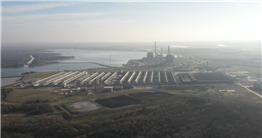Bitcoin mines cash in on electricity — by devouring it, selling it, even turning it off — and they cause immense pollution. In many cases, the public pays a price.
The Bitdeer mine in Rockland, Texas.Credit…Video by Jordan Vonderhaar
Supported by
Send any friend a story
As a subscriber, you have 10 gift articles to give each month. Anyone can read what you share.
By Gabriel J.X. Dance
Graphics by Tim Wallace and Zach Levitt
Gabriel J.X. Dance traveled to Texas and North Dakota, interviewed Bitcoin miners, energy experts, scientists and politicians and analyzed thousands of records detailing mining operations for this story.
Texas was gasping for electricity. Winter Storm Uri had knocked out power plants across the state, leaving tens of thousands of homes in icy darkness. By the end of Feb. 14, 2021, nearly 40 people had died, some from the freezing cold.
Meanwhile, in the husk of a onetime aluminum smelting plant an hour outside of Austin, row upon row of computers were using enough electricity to power about 6,500 homes as they raced to earn Bitcoin, the world’s largest cryptocurrency.
The computers were performing trillions of calculations per second, hunting for an elusive combination of numbers that Bitcoin’s algorithm would accept. About every 10 minutes, a computer somewhere guesses correctly and wins a small number of Bitcoins worth, in recent weeks, about $170,000. Anyone can try, but to make a business of it can require as much electricity as a small city.
In Texas, the computers kept running until just after midnight. Then the state’s power grid operator ordered them shut off, under an agreement that allowed it to do so if the system was about to fail. In return, it began paying the Bitcoin company, Bitdeer, an average of $175,000 an hour to keep the computers offline. Over the next four days, Bitdeer would make more than $18 million for not operating, from fees ultimately paid by Texans who had endured the storm.
The New York Times has identified 34 such large-scale operations, known as Bitcoin mines, in the United States, all putting immense pressure on the power grid and most finding novel ways to profit from doing so. Their operations can create costs — including higher electricity bills and enormous carbon pollution — for everyone around them, most of whom have nothing to do with Bitcoin.
Until June 2021, most Bitcoin mining was in China. Then it drove out Bitcoin operations, at least for a time, citing their power use among other reasons. The United States quickly became the industry’s global leader.
Since then, precisely how much electricity Bitcoin mines are using in America and their effect on energy markets and the environment have been unclear. The Times, using both public and confidential records as well as the results of studies it commissioned, put the most comprehensive estimates to date on the largest operations’ power use and the ripple effects of their voracious demand.
Source: Read Full Article
-
WGA Sends Out Ratification Ballots To OK New Studio Contract; Read Email To Guild Members
-
European Shares Seen Mostly Higher As US Averts Shutdown
-
U.S. Stocks Rally On Weaker Than Expected Service Sector Reading
-
WGA West Sets First Membership Meetings To Discuss Upcoming Contract Talks
-
FDA Approves New Therapy For Rare Blood Cancers




